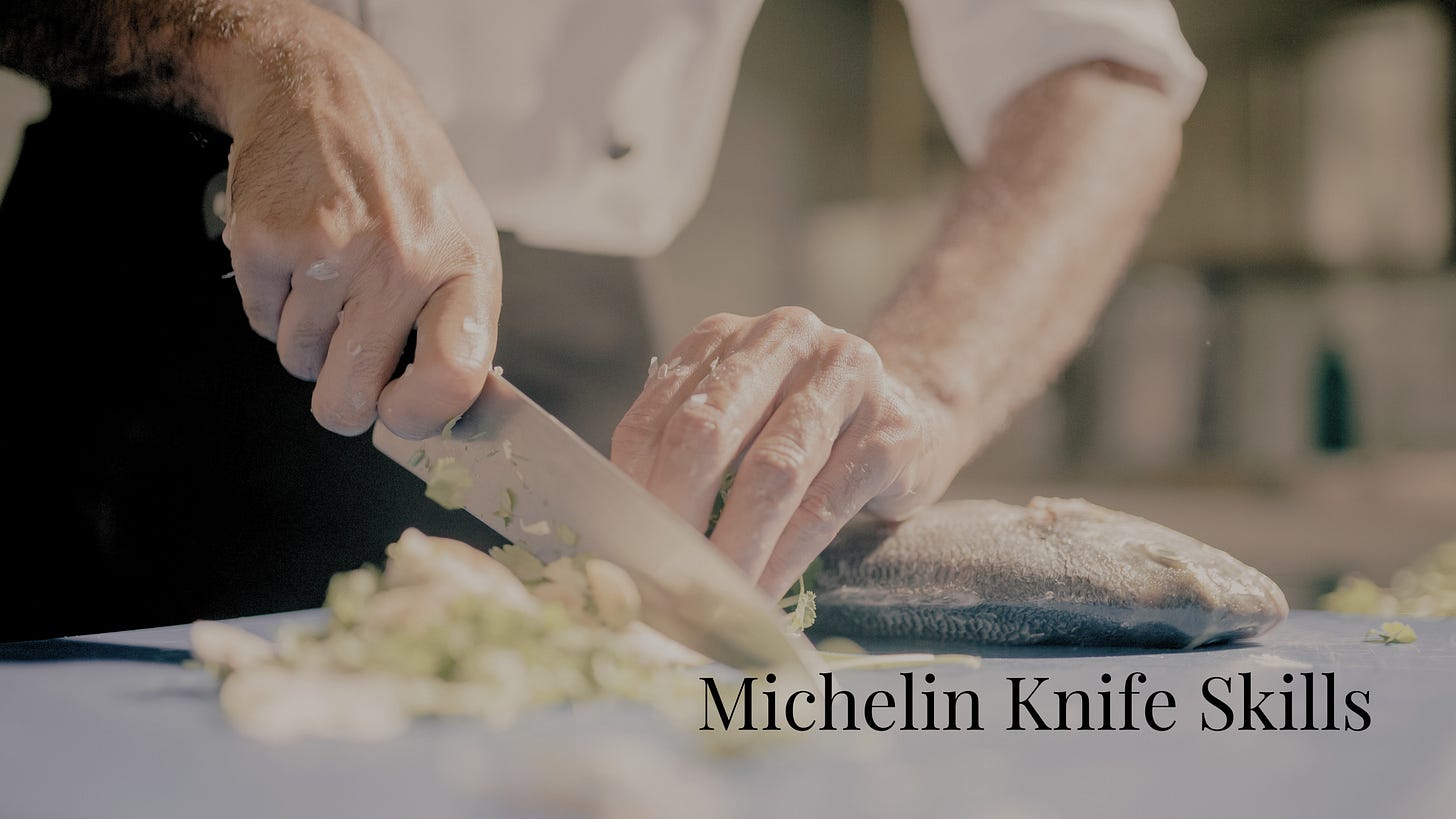How Many of These Knife Mistakes Are You Making?
Small changes in how you hold and use a knife can make a big difference. Are you making these common mistakes?
Ever go to someone's house for dinner and you watch them cook? When I do, because I've worked in fine dining restaurants for over 15 years, I can't help but cringe. The way the knife is used and which knife is used keeps me in constant concern for their fingers. I DON'T need more iron in my diet, thanks. So I thought I would share how the Michelin chefs and cooks avoid finger mutilation when cooking. And they do it under intense pressure and speeds!
Mastering Michelin-Level Knife Skills in Your Home Kitchen
A sharp knife in the right hands transforms cooking from a chore into an art. Michelin-starred chefs understand that proper knife skills aren’t just about speed but also about precision, safety, and efficiency. Here’s how you can refine your knife technique and elevate your home cooking to a professional level.
1. The Foundation: Proper Knife Grip
Holding your knife correctly ensures better control and reduces fatigue. The standard grip techniques include:
Pinch Grip – Pinching the blade between your thumb and forefinger while wrapping the other fingers around the handle for better control.
Handle Grip – Holding the handle firmly with all fingers, offering stability but less finesse than the pinch grip.
Stabilizing Hand Position:
The Claw Grip – Curl your fingertips under and rest your knuckles against the blade. This technique keeps your fingers safe while providing stability and guidance for the knife.
Flat Palm Method – Place your free hand flat on top of larger ingredients to stabilize them while slicing, ensuring fingers remain safely away from the blade.
2. Essential Cutting Techniques
Mastering different cutting styles ensures even cooking and professional presentation.
Rock Chop: Best for herbs, onions, and vegetables. Keep the tip of the knife on the cutting board and rock the blade up and down.
Slice: A forward and backward motion for clean cuts through proteins, vegetables, and bread.
Julienne & Brunoise: Thin matchstick cuts (Julienne) that can be further diced into small cubes (Brunoise).
Chiffonade: Rolling leafy greens into a tight cylinder before slicing into thin ribbons.
Bias Cutting: Angled slices for aesthetic presentation and increased surface area for marinades.
Watch This Michelin Chef Demonstrate Proper Knife Techniques:
Mastering different cutting styles ensures even cooking and professional presentation.
Rock Chop: Best for herbs, onions, and vegetables. Keep the tip of the knife on the cutting board and rock the blade up and down.
Slice: A forward and backward motion for clean cuts through proteins, vegetables, and bread.
Julienne & Brunoise: Thin matchstick cuts (Julienne) that can be further diced into small cubes (Brunoise).
Chiffonade: Rolling leafy greens into a tight cylinder before slicing into thin ribbons.
Bias Cutting: Angled slices for aesthetic presentation and increased surface area for marinades.
3. Choosing the Right Knife for the Task
Each knife serves a specific purpose, and knowing when to use each one can drastically improve your cooking experience.
Knife Best For Chef’s Knife All-purpose slicing, dicing, chopping Santoku Knife Precision slicing of vegetables, meats, and fish Paring Knife Small tasks like peeling, trimming, and coring Bread Knife Slicing bread, tomatoes, and other soft foods with tough exteriors Boning Knife Removing bones from meat and fish Cleaver Heavy-duty chopping for meats and hard vegetables Utility Knife Mid-sized tasks where a chef’s knife feels too big but a paring knife too small.
4. Keeping Your Knives Razor Sharp
Dull knives are dangerous because they require more force, leading to accidents. Maintain your blades by:
Honing Daily – A honing steel realigns the edge without shaving off metal.
Sharpening as Needed – Use a whetstone or professional sharpening service when the knife no longer cuts cleanly.
Proper Storage – Knife blocks, magnetic strips, or blade guards help maintain the sharpness. Avoid resting the blade directly in the block, as the weight can dull the edge over time. Dull knives are dangerous because they require more force, leading to accidents. Maintain your blades by:
Honing Daily – A honing steel realigns the edge without shaving off metal.
Sharpening as Needed – Use a whetstone or professional sharpening service when the knife no longer cuts cleanly.
Proper Storage – Knife blocks, magnetic strips, or blade guards help maintain the sharpness.
5. Common Knife Mistakes & How to Fix Them
Using the Wrong Knife for the Job – Avoid using a serrated knife for slicing proteins or a paring knife for chopping vegetables.
Applying Too Much Force – Let the sharpness of the knife do the work rather than pressing down excessively.
Not Using a Stable Cutting Board – Always use a damp towel underneath the board to prevent slipping.
Bringing It All Together
Investing time in your knife skills makes cooking easier, safer, and more enjoyable. Mastering these techniques will not only make you more efficient in the kitchen but also bring a refined, professional touch to your dishes.
Stay tuned for more cooking fundamentals as we continue refining our kitchen techniques in The Flame!
Fascinated by professional cooking techniques? Learning proper knife skills isn’t just about efficiency—it’s about safety, precision, and enhancing your entire culinary experience. What’s your take on the importance of knife skills in home cooking? Do you think every home cook should learn Michelin-level techniques, or are basic skills enough? Share your thoughts below!
Not Your Grandmother’s Recipe Cards
Signature Series February Edition
If you want it, buy this recipe card now…before the price goes up March 1st!
Not what you are looking for? Go to The Earth & Flame Shoppe to see all of the recipe cards, checklists and menu designs are I’m constantly coming out with new designs.
Bundles are coming soon!
Want to Work Together? Here’s How I Can Help:
Custom Menu & Recipe Card Designs
I’ll craft menus and recipe cards tailored to your unique style, perfect for sharing recipes or building a collection to turn into a personalized cookbook.Healthier Living Without the Overhaul
Need help incorporating herbs, teas, and nutrient-dense foods into your daily life? My blog and newsletter offer tips and programs to make healthier living approachable and enjoyable.AI-Powered Writing and Newsletter Management
Let me handle your content creation! I specialize in writing for luxury travel, wellness, and food brands, with packages starting at $1,500, including:Custom-written blog posts or newsletters.
Platform management (Substack, Mailchimp, etc.).
Social media content suggestions.
Strategic content planning.
Let’s Create Something Extraordinary Together!
I’ve combined my love for food, publishing, agriculture, and travel to help food artisans, wellness brands, and luxury experiences shine. Whether you’re a chef, restaurant owner, or a brand in the world of wine, coffee, teas, or herbs, I’m here to support you. As a solo traveler with a child, I understand the balance between exploring the world and creating meaningful connections through food and lifestyle. From farm-to-table dining to seasonal living, I’m passionate about sharing unique wellness experiences that inspire. Let me know what topics you’d like me to cover or how I can help bring your brand’s story to life.
Thanks for reading and being part of The Earth & Flame!






